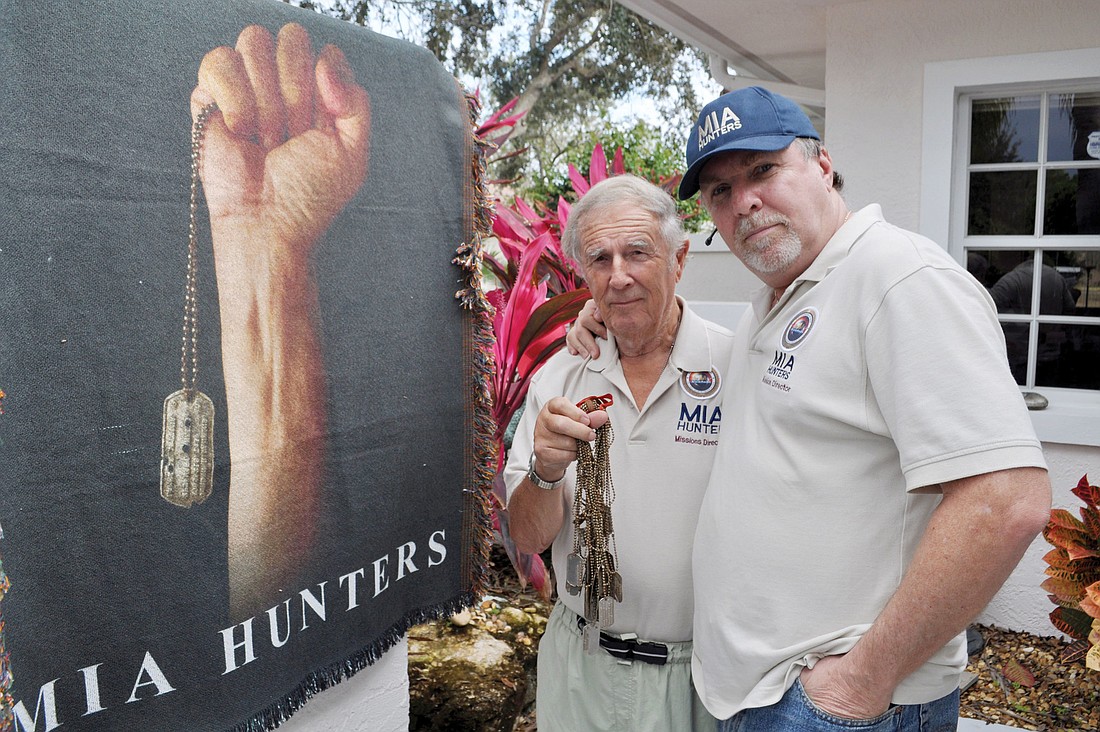- November 27, 2024
-
-
Loading

Loading

Sixty miles inside the Papua, New Guinea jungle, a group of volunteers forged crocodile-infested rivers; hiked in tropical heat; and endured torrential rain to reach the top of a mountain. Led by native guides, the group arrived at its final destination. There, concealed in the thick jungle brush, previously unexplored by outsiders, is the crash site of a World War II U.S. bomber containing the remains of 11 MIAs. The group said a prayer for the aircrew members who lost their lives 65 years ago, before they placed an American flag in the soil.
The discovery is one of approximately 70 crash sites discovered by the non-profit civilian organization, MIA Hunters, on its 2010 mission to Papua, New Guinea, which turned up the remains of more than 500 lost U.S., Australian and Japanese airmen and soldiers. After each discovery, the organization, founded and led by 82-year-old Bryan Moon, sends photos and GPS locations of its findings to the U.S. Army’s MIA recovery operation in Hawaii, which will then identify the remains through forensic testing and return them to the next of kin.
MIA Hunters was born out of expeditions by British-born Bryan Moon and his son, Christopher Moon, who traveled the world in the ’90s to discover downed historical aircraft.
Bryan Moon, an artist who served in the Royal Air Force, and Christopher Moon, a documentary filmmaker, originally teamed up to tell the stories of their discoveries through film and art. But when several of their missions turned up airmen remains, the two saw an opportunity to provide a much-needed service.
“The more fine-tuned our process became, we found ways to give our missions greater purpose and meaning,” says Christopher Moon. “It was clear that there were more important things to find than just airplanes.”
In 2001, the men were surprised when they were approached by a woman, who sought their help in finding her brother, an MIA pilot. Intrigued, they decided to narrow their focus, and Bryan, along with his late wife, Dona Moon, son Christopher Moon and daughter-in-law Cicely Moon, formed MIA Hunters.
Christopher Moon says this first hunt was extremely expensive and time consuming, but despite the difficulties, it solidified the need for their work.
“People talk about finding a needle in a haystack,” he says. “This is like finding a needle in a field of haystacks. These are young guys who went and gave their lives for their country, and there they stay. Their families can’t rest. Try going through that and not continuing the work we do.”
Today, the organization is led the Moons, who recently moved to Sarasota from Minnesota. Their motto is “the few, searching for the many,” and for good reason. Twenty years later, the registered 501(c)(3) non-profit organization has grown, but still remains small, with 32 volunteers working on its largest mission, in 2010. The group operates on a strictly volunteer basis, with no funding. Trips are largely funded by the Moon family, and volunteers pay their own way, at about $10,000 per person.
MIA Hunters has been recognized by the United States Department of Defense as the most successful civilian-led MIA recovery group in the country. An estimated 68,000 U.S. MIAs, mostly from World War II, remain lost, but throughout the course of 33 missions, spanning more than 20 years, the group has successfully recovered, identified and returned more than 500 American MIAs.
“That’s the most touching part,” says Christopher Moon. “Being able to finally provide closure for the loved ones. When you look into their eyes, and you see 60 years of anguish — 60 years of missing someone they love — and you can end that pain, it’s really something else.”
Bryan Moon attributes their success to their ability to gain access to dangerous remote jungle areas and earn the trust and cooperation of the native people. With more than 2,000 variations of the indigenous language, many of which have no word for “airplane,” he says it takes a lot of work to foster these relationships, but the organization now has a reliable group of native people, who work as scouts, scouring the mountains and reporting their findings to the MIA Hunters.
“It’s a simple approach,” he says. “I’m not sure why no one else has thought to do it. Who knows the jungles better than the native people? Why not employ them?”
Considering the level of danger associated with their missions, and the many close calls they’ve encountered, the father/son duo says that the most challenging part of their work lies in securing funds for the expensive trips and garnering volunteers and other support. Despite the challenge, they both feel that it’s their duty to continue their efforts.
MIA Hunters is preparing to embark on another mission to Laos, where they hope to end a five-year effort to recover a 70-year-old U.S. MIA Vietnam vet, who is reported to still be alive. Other plans include returning to Papua to explore recently discovered mass burial grounds, which could produce hundreds more MIAs. The work is dangerous, expensive and exhausting, but the MIA Hunters are determined to press on.
“When you finally see the bomber in the jungle, and you’re about to approach it, you know that there are likely 11 MIAs inside,” says Bryan Moon. “This is your moment. Because of the work you did, 11 families will get phone calls, and 11 MIAs will finally be coming home.”